March 2001 (Part 2)
SELECTION OF QUESTIONS AND ANSWERS
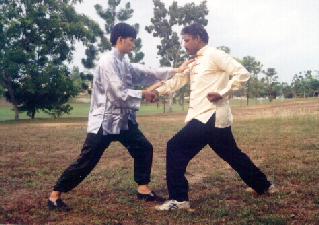
Tactic of feign opening. See Questions 8 and 9. Mogan attacks with a common right punch, leaving a feign opening. Tai sinks the attack and immediately thrusts his left palm at Mogan's throat, falling into Mogan's trick.
Question 1
What is the Chinese attitude towards sickness? Is it punishment for sins or just a part of life?
— Timo, USA
Answer
Sickness is neither punishment for sins nor just a part of life. The Chinese do not pay much attention to sickness! They pay attention to health, which is symbolically represented as yin-yang harmony.
Health, or yin-yang harmony, is natural. This means without having to do anything, a person — any person — is healthy. He (or she) loses this natural state when one or more systems in his body (and mind) fail to function naturally.
Sickness, or yin-yang disharmony, is unnatural. Because it is unnatural, sickness — irrespective of the different names people may label its countless symptoms — is only temporary and can be rectified. One excellent way to restore yin-yang harmony is practising genuine chi kung.
Question 2
Do you have an explanation for my experiences with psychic powers such as street lights going off and foretelling the future (knowing who will call me in 15 seconds)?
Answer
Yes, these experiences are natural, i.e. they are not man-made, and can be explained by natural reasons, i.e. without resorting to faith or superstition.
But through many centuries peoples whose cultures have been much tempered by man-made technology and philosophy, have wandered far off from their originally natural abilities, and view them as extraordinary or supernatural.
The Chinese view man (and of course that also means woman) to be composed of three “elements”, namely jing, qi and shen, or physical body, energy and mind.
When you energy flow is powerful and interferes with the energy of street lights, you may, without your conscious knowing, turn the lights off. When your mind, again without your conscious knowing, picks up impulses and you interpret them correctly, you can foretell someone calling you in 15 seconds.
All of us have these natural abilities, but most people have these abilities blunted by countless and varied factors. A people whose culture looks at events only from the physical perspective, will lack the concept to understand them, as well as the vocabulary to explain.
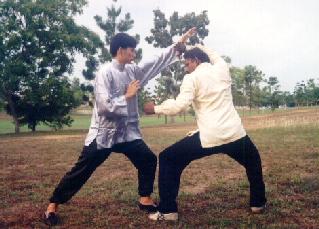
Mogan shifts to a side-way Horse-Riding Stance, “floats” Tai's palm thrust and simultaneously strikes Tai's exposed ribs with his left fist, at a time when Tai expects his left palm thrust to connect.
Question 3
As you now know my situation I'm wondering if there are any rural places (not modern cities) where I could go for a few years to get better and train some martial art?
Answer
What you need is to learn chi kung — not martial art — from a genuine master, and then practise diligently what he has taught you. You do not need to go to a rural place. You can practise at the place where you live and work.
Chi kung — or high level martial art — is to enable us to do better what and where we have to do, not an excuse for us to run away from our daily life.
Question 4
Do you think qigong could be helpful for me? Please bear in mind that my problem is a poison (mercury) in my system. I'm doing really everything in my powers already with nutrition, water supply and slow walks to get the mercury out.
Answer
Certainly. Chi Kung (Qigong) is probably your best choice, but you have to learn from a genuine master. Your effort so far has been useless because nutrition, water supply and slow walks are not meant for detoxification, whereas chi kung is. Moreover you are not an expert in nor have sought expert advice on any of the things you did.
You have been wasting your time, and considering the precarious situation you are in, you have been unwise. In the same way, if you are so unwise as to try chi kung on your own without learning personally from a genuine master, your effort in qigong will also be a waste of time.
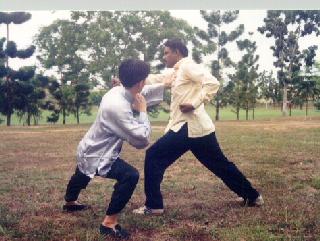
There are other ways to counter a common right punch. Here is another example. As Mogan attacks, Tai moves diagonally to his right side and simultaneously counters with a left phoenix-eye fist at Mogan's heart. But Mogan is ready for this possible counter from Tai.
Question 5
I would like to learn some martial art and teach that in the future
Answer
From my experience, those who want to teach others a martial art which they have not even learnt, do not have the discipline and perseverance to become satisfactory students themselves.
Have some respect for the art you wish to learn or the responsibility you wish to assume. If it can be learnt or be taught so easily, either it is a low class art or you are a low class teacher.
Becoming a teacher is assuming a heavy responsibility. Have some thought and care for your students. Ensure you are well qualified before thinking of teaching others. In the Buddhist teaching, there are three levels of charity, namely the giving of material, the giving of service, and the giving of teaching. Becoming a teacher is assuming the highest level of charitable act, not an excuse to inflame one's ego.
Question 6
I was initiated in kungfu four years ago. Unfortunately the kung fu there was of bad quality, although we were taught some form. When it came to kung fu application we were advised to drop the animal patterns and fight more “efficiently”, by directly attacking our target throwing punches and kicks. As a result we ended up sparring like children.
— George, Cyprus
Answer
This is the norm in most kungfu schools today, in the East as well as in the West. That is why the standard of kungfu is so shamefully low. At least these people attempt to fight, though they hurt themselves.
In the form of modernized kungfu called wushu, officially promoted by wushu associations all over the world often with certified teachers from China who usually have won state or national competitions, there is not even any attempt to defence oneself. But these wushu practitioners do not hurt themselves and their performance is beautiful to watch.
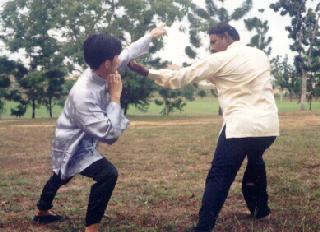
Mogan moves his front leg diagonally backward to his left side, and simultaneously srikes Tai's attacking elbow wtih a reversed left leopard fist. If this illustration is seen in isolation, those used to free sparring may think this counter unrealistic. “No one would lift up his left hand for you to strike his elbow,” they may claim. Little do they realize that a successful application of this reverse leopard fist is due to a skilful use of tactics.
Question 7
Recently I found a great kung fu school nearby so I began training there. I have began training in form and partial application. Now although I am being taught some genuine application our sifu doesn't encourage Shaolin style of fighting. Yes he teaches us genuine form and techniques to practice but when it comes to sparring our system is very similar to karate, although we don't spar like children any more.
Answer
This is a mediocre kungfu school, not a great one. In a really great kungfu school, which is as rare as gem today, you learn not only to defend yourself effectively but also to develop internal force and spirituality.
Question 8
Therefore I try to take out of the forms I'm being taught techniques I could use in combat. Most of the times I understand what the application of each technique is but I am facing problems in combining movements and patterns.
Answer
If you do correctly, you are repeating what early kungfu exponents did centuries ago at the start of the long history of kungfu development, with the crucial exception that individual patterns came before complete sets. The first generations focused on application of individual techniques.
But unlike you who face problems in combining movements and patterns, the next generations combined them into suitable sequences. Then they devised tactics and strategies, and developed different approaches of sparring to be combat efficient.
Parallel to this development on forms, they improved formless aspects like force, speed and other skills. Initially their methods were crude, like lifting weights, running and punching sandbags. Gradually they refined their methods until the uninitiated might not even recognize that these methods could help combat efficiency, such as stance training and abdominal breathing.
Hence, over many centuries kungfu fighting which was at first not much different from free-style fighting, gradually developed into an incredibly extensive and profound martial art we inherit today. But the climax of kungfu development is not today; it was probably a few hundred years ago. Today kungfu is declining sharply — so sharply that if you can kick about and beat a few blackbelts you could be called a kungfu master.
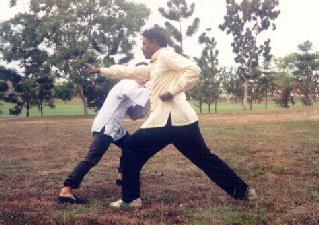
This illustration shows a third possible counter against a common punch. Tai moves diagonally to his left side and counter strikes with a right punch at Mogan's right ribs almost at the same time Mogan completes his initial attack. Against many opponents, Tai's counter would have connected.
Question 9
For example I know that by shifting my body backward (to what you call “Taming the Tiger”) I can avoid high kicks or even chain punching attacks, but how should I counter attack? Should I sweep my opponent (as in one of my forms there is a combination of the two patterns) or should I return back to Bow-Arrow Stance throwing out a backfist followed by a straight punch in the face and then carry on with a straight kick in the lower abdomen?
Answer
Shifting your body backward to avoid high kicks or chain punches is the first stage. When you can perform this well, you progress to the next stage, like sweeping your opponent or returning to a Bow-Arrow Stance and simultaneously throwing out a backfist. The standard of martial arts today is so low that if you can perform this second stage well, you can beat many opponents, even at the black-belt level.
If your opponent is well trained, he will go to the third stage, where not only he knows the possible counters you would respond to his initial attacks but he is also trained to counter your possible counters. In other words, he does not have to think of what to do when you sweep him or backfist him. He spontaneously reacts to your counters.
Similarly, if you are also trained in the third stage, you will also respond spontaneously to his counters. Then he will counter your counters, and so on. This will lead to the fourth stage. You use a trick. As he attacks, you respond with a usual counter. As he responds to your expected counter, you catch him by surprise by changing the expected to an unexpected. Here you have progressed to tactics.
Then you progress to strategies. Not only you employ appropriate techniques and tactics, you plan so that he would, often without his knowing, fight in a way favourable to you. You make the strategy not during the fight but before the fight. You may, however, change to another strategy during a fight.
Question 10
Or how do I apply some drunken boxing techniques such as the fall back kick forward technique? It is all so confusing and most of the times my sifu cannot help me with all my questions.
Answer
Here is one example. Your opponent attacks you in front, such as with a whirlwind kick or a thrusting knife. You lean back at your waist and kick up with one leg at him. You must be sure you are very skilful in this technique before attempting to use it.
There is nothing confusing. It is only confusing to those who do not know. You sifu could not help because, like most modern sifus, he does not know.

But Mogan is prepared for this possibility; his initial attack is a feign, purposely leaving an apparent opening to trick the opponent. Just as Tai thinks his punch has connected, Mogan curves his body backward, with his right hand sweeps away Tai's punching arm, grips Tai's right wrist and pulls him forward, while simultaneously his left hand grips Tai's neck at the back, and his right knee strikes Tai's chest — all in one smooth movement.
Question 11
Although what I am being taught now is genuine, some application is not taught to me. Should I carry on studying with this teacher, learning and composing my own applications and patterns from the forms?
Answer
What you practise may be genuine kungfu forms but not genuine kungfu. If you practise genuine kungfu, even if it is of a low level, you must be able to use it for combat, even if you lose much of the time.
Whether you should carry on with the same teacher depends on various other factors too, not just on combat efficiency. If faced with only two choices — which actually apply to most people — I would think it better to carry on with a teacher who teaches you genuine kungfu forms (albeit not genuine kungfu) and you enjoy toying with the application from your own composition, than changing to another teacher who often asks you to free spar, which practically means punching and kicking each other generously, and hurting yourself physically and psychologically.
Question 12
I am a bit weak when it comes to close range combat and chain punching techniques so I was thinking of joining a Wing Chun school to develop better close range fighting skills. Should I do that or will it confuse me even more as it won't combine to my Shaolin style?
Answer
Again your choice depends on many variables. Define your aims and objectives and decide which school better helps you to attain them.
Also take note that yours is an example of what is called in Zen as dualistic thinking. You think that Wing Chun is better than Shaolin in close range combat, but this is not necessary so. Even if Wing Chun were better, it does not necessarily follow that by practising Wing Chun you would be better in close range combat.
Question 13
My Shaolin system encourages the Horse Stance as its basic stance when sparring. I have difficulties in side-stepping when sitting in a Horse Stance viewing an opponent on the right. Could you give me a tip or two on how to change stances to side step when being chain punched?
Answer
Your weakness is called in kungfu terms as “stable but not agile”, but you might not even be stable. In Shaolin philosophy, one should not remain doggedly at any one stance. He should use the stance, or even no stance, best suited for that particular situation. In fact of all martial arts Shaolin Kungfu has the widest range of stances.
Let us say you are sitting on a side-way Horse-riding stance and looking at your opponent on your right. If you want to side step to your right, momentarily transfer your weight to your left back leg and move your right leg to your right side to any suitable stance. If you wish to move left, momentarily transfer your weight to your right front leg and move your left leg to your left side to any suitable stance.
Take note that the start of the movement is from your heart, which means the mind. Breathing in gently as you move will improve your agility.
But you don't have to necessarily side step. Chain punches are relatively easy to counter. As your opponent attacks you, without moving your feet, move your body slightly forward and simultaneously use your right hand to push at his right elbow pushing his two hands to his left side, and with your left hand strike his exposed left ribs. Here you employ a tactic called “one hand tames two hands”. No matter how fast or continuous his chain punches may be, he cannot harm you.
Alternatively, as he attacks, without moving your feet, shift your body slightly backward and simultaneously grip his left wrist with your left tiger-claw, straighten his left arm and press at his left elbow with your right palm, felling him to the ground. Here you use a tactic called “using far to subdue near”.
Assuming all other things being equal, which is usually not valid, here are two examples where Shaolin Kungfu is superior to Wing Chun in close range combat.
